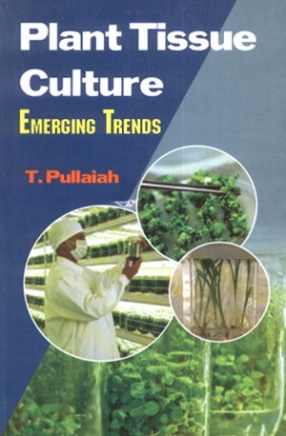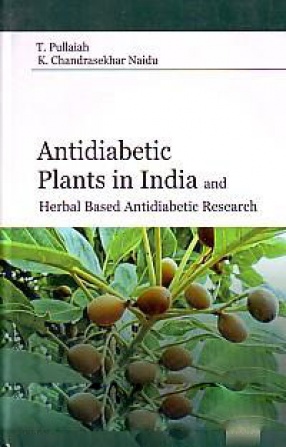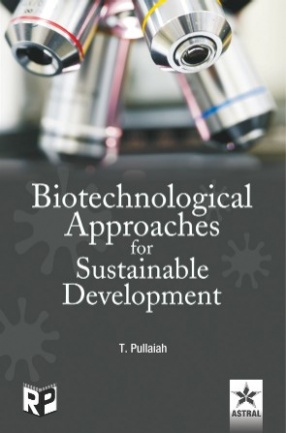
T Pullaiah

55 books
















This 5-volume set, Ethnobotany of India, provides an informative overview of human-plant interrelationships in India, focusing on the regional plants and their medicinal properties and uses. Each volume focuses on a different significant region of India, including:
Volume 1: Eastern Ghats and Deccan
Volume 2: Western Ghats and West Coast of Peninsular India
Volume 3: North-East India and Andaman and Nicobar Islands
Volume 4: Western and Central Himalaya
Volume 5: ...

Flora of Thummalapalle Uranium Mining Area in Kadapa and Anantapuramu districts of Andhra Pradesh is the base line floristic study of 30 km radius from the Mining site. A total of 892 taxa belonging to 869 species under 455 genera and 104 families of Angiosperms have been enumerated. Pteridophytes include 14 species under 13 genera and 12 families while Bryophytes include 22 taxa belonging to 21 species under 14 genera and 8 families. Under each family key to the ...



The book comprises of different chapters associated with methodology in Plant science (Botany), describing in a simple and comprehensive way. The importance of creativity and motivation in research, the planning and proposal of research project, the description of different techniques involved in research are described in an elaborate way. It also includes the sources/collection of scientific information, method of scientific report/paper/thesis writing etc. The ...

This is a textbook on Biodiversity, Conservation and Management for the undergraduate and post-graduate students in Botany. It covers syllabus of most of the Indian Universities on the above subject. It is written in simple and lucid manner. The book running to 122 pages covers Nature, Values and Distribution of Biodiversity, Conservation of Biodiversity, Global and National Biodiversity Conservation Initiatives and Remote Sensing and Plant Resource Management. ...

In continuation of the series the present volume includes nine chapters from different parts of India. Floristic diversity in Uttara Kannada district, Karnakata is dealt with in the first chapter. It is followed by Diversity of Asterinaceous Fungi in Sirumalai Hills, Eastern Ghats. Third chapter is on Floristic diversity of Malkangiri district in Odisha. Daniels has given an Overview of Epiphyllous Liverworts of the Southern Western Ghats. Chapter 5 deals with ...

The Telangana State has been intensively explored by the author and his scholars for plant wealth during the last 30 years. All the herbaria in India have been consulted for the specimens of Telangana. The first volume include Introduction, Topography and general features, Forests and Vegetation, Past and Present work, Key to the families and systematic enumeration families Ranunculaceae to Alangiaceae. The second volume includes families Rubiaceae to ...

This volume of edited book on Biotechnological approaches for sustainable development brings together diverse topics on Biotechnology. Probiotics, an important aspect in human health, is dealt with in the first chapter. An overview on Molecular markers which are bing used in improvement of crop plants is given in chapter 2. Orchids are important group of horticultural plants and their DNA sequencing and in vitro seed germinaltion are given in chapters 3 and 4 ...

The present Volume 7 of Biodiversity in India includes 18 chapters covering broad spectrum Biodiversity. It includes Balsaminaceae in Tamil Nadu, Loranthaceae and Viscaceae in Karnataka, Bryophytes of Western Ghats, Pholidota in Himalayas, Lepisorus in Nilgiris, Macrofungi in Kodagu region and Snakes of Sri Krishnadevaraya University campus. A few chapters deal with Non Timber forest produce, medicinal plants and wild edible plants are also dealt with. Ex situ ...

This book is the result of extensive field trips and laboratory students undertaken on bryophytes of Andhra Pradesh. The information of such a work usually gets limited to various periodicals/journals and not easily accessible. In order to make better use of this dispersed information, we have made an attempt to consolidate it in the form of a book. The approach adapted, presents information in an easy – to grasp form so that it could be understood not only ...

The present Volume 6 of Biodiversity in India includes eight articles covering diverse subjects. First chapter is about one horned Rhinoceros conservation in Assam followed by the Amphibians in Western Ghats. These two areas constitute the Hot Spots of Biodiversity. Third chapters is on Floristic diversity of Nawarangpur district in Odisha. It is followed by pollination of some endangred Impatiens species in Western Ghats. Chapters 5 deals with Flora of North ...

The book 'Biostatistics' consists of ten chapters explaining statistical tools used in analyzing biological, biomedical and biochemical experimental data. Statistical tools, techniques and methods are explained with many real life problems and special care is taken to explain mathematical formulae and calculations keeping in view that the readers are non-mathematical students who are not having much mathematical background.
The book mainly concentrates on (1) ...

Abiotic stress such as drought salinity cold and soil acidity cause a great loss to agricultural crops. Other stresses like zinc deficiency soil nutrient deficiency and elevated CO2 also are responsible for crop loss. The effects of these on molecular mechanisms have to be stressed. In the present book effect of abiotic stress and molecular mechanisms involved in abiotic stress tolerance is given in chapter 1. Genetic engineering of plants for enhancing abiotic ...


Caralluma has attracted the attention of general public because of its antiobesity activity and fascinating cacti growth with ornament flowers. If you search for Caralluma on the internet you get hundreds of websites for its antiobesity properties. Capsules of this plant are being sold in the west at exorbitant prices. It is a million dollar business. Because of this public has developed interest on this plant. This plant group is much attracted the gardeners, ...

Encyclopaedia of Herbal Antioxidants, gives information on antioxidant activity of different plant species. The book is divided into four sections. Section I gives an account of free radicals and their effect on human health. It also gives an account of different ways of free radical generation. Section II gives different antioxidant assays. It includes DPPH assay, Determination of Nitric oxide, Determination of hydroxyl radical scavenging activity, Determination ...

The present volume 5 of Biodiversity in India includes ten articles with main emphasis on medicinal plants and ethnobotany. For the first time we included of animal diversity. The first article is on Millipedes and their conservation. The next two articles are on medicinal plants against respiratory complaints and eye diseases. Ethnobotany of East Godavari district is given in Chapter 4, Anantapur District in Chapter 7 and Komaralad Mandal in Chapter 8. Medicinal ...

During the last couple of decades plant cell tissue and organ culture has made considerable advances. This book brings together 12 chapters on emerging trends in plant tissue culture. Tissue culture of tree legumes and sterculiaceae are given in the opening articles. Nagesh and Shanthama have given details of regeneration, organogenesis and somatic embryogenesis in Curculigo orchioides in chapter 3. Micropropagation of Talinum cuneifolium is the next article. ...

The Eastern Ghats, one of the nine floristic zones in India, are located between 11degree and 50’ and 86 degree 30’ E longitude in a north-east to South west strike. The Eastern Ghats are spread over three states of India, namely Orissa, Andhra Pradesh and Tamil Nadu. It covers an area of about 75,000 sq. km. With an average width of 200 km in the north and 100 km in the South. They extend over a length of 1750 km between the rivers Mahanadi and ...

The book includes the biographies and contributions of 75 eminent Indian Botanists and explains the foundations of Botany in India and its development from 16th century into modern times. The biographies mentioned herein include those plant explorers of the East India Company like Garcia d’Orta, Hendrik A. Van Rheede and H. F. C. Cleghorn who laid the foundations to Tropical Medical Botany. This also includes the biographies of the scientists of ...

The book includes 20 research and review articles on various aspects of Biological Sciences written by leading experts. The first article is on M6P / IGF-IIR protein. It is followed by two articles on VAM Fungi. The following two articles are on antimicrobial activity of medicinal plants. Chapters 6 and 7 deal with the toxicity of fungal infections. Airborne bacteria is given in the following chapter. Cyanobacterial diversity is described by Gupta in the next ...

This book comprehensively deals with higher plants (Angiospermic plants) found, in the area of Anantapur district which lies between 13o 41' and 15o 14' north latitudes and 76o 47' and 78o 26 east longitudes. The district covers an area of 19130 sq. km. The species have been enumerated systematically. Dichotomous keys have been provided to the families, genera and species which are mostly artificial. The systematic treatment under each family includes the ...

The state has been explored intensively by the authors for plant wealth during last 14 years. A total of about 2500 species of angiosperms occur in the state. Bentham and Hooker's system of classification has been followed in the enumeration of families with certain exceptions to accommodate recent changes. A dichotomous indented key is given for families, genera and species. Under each family key to the genera followed by the genus with its authority, key to the ...
